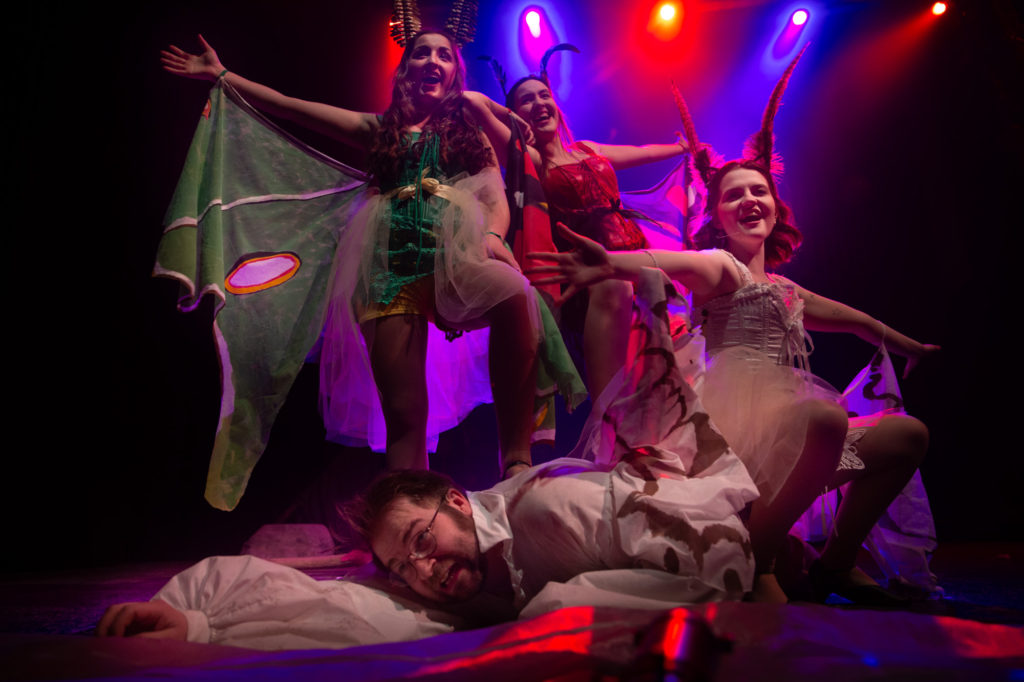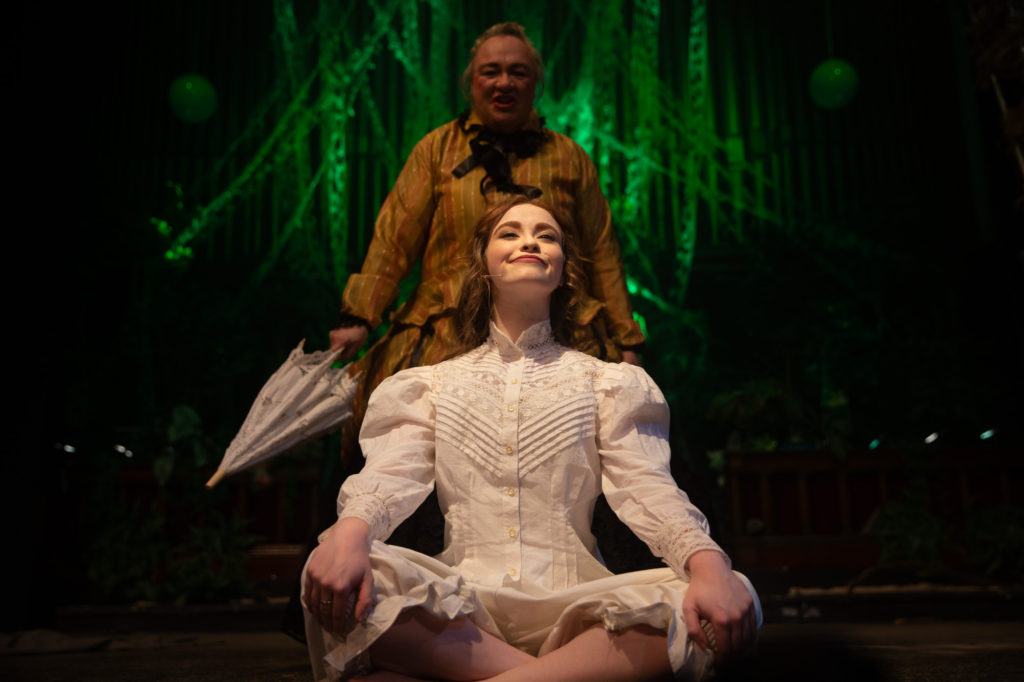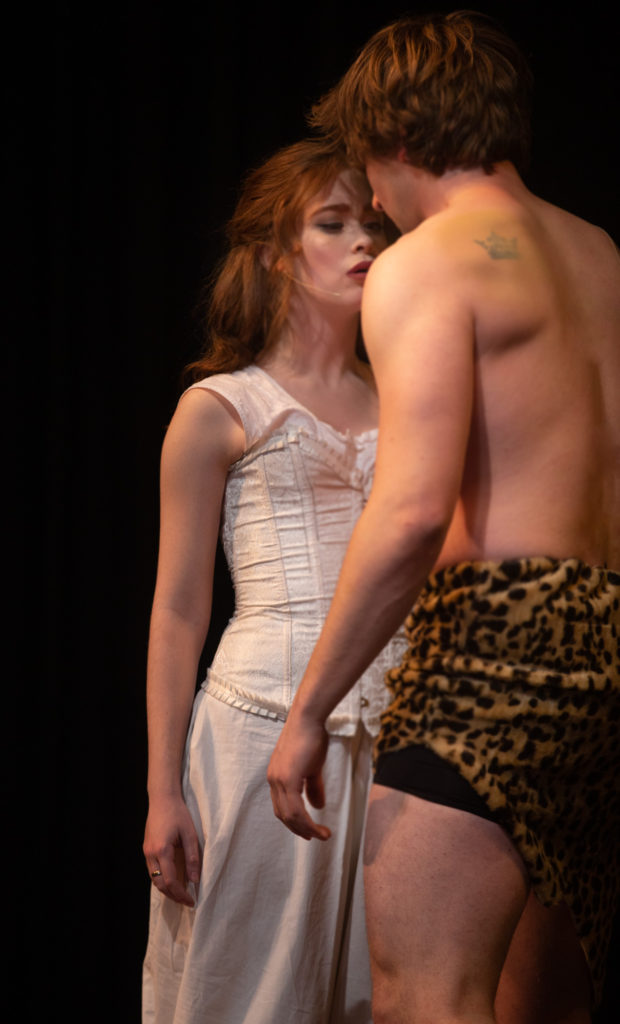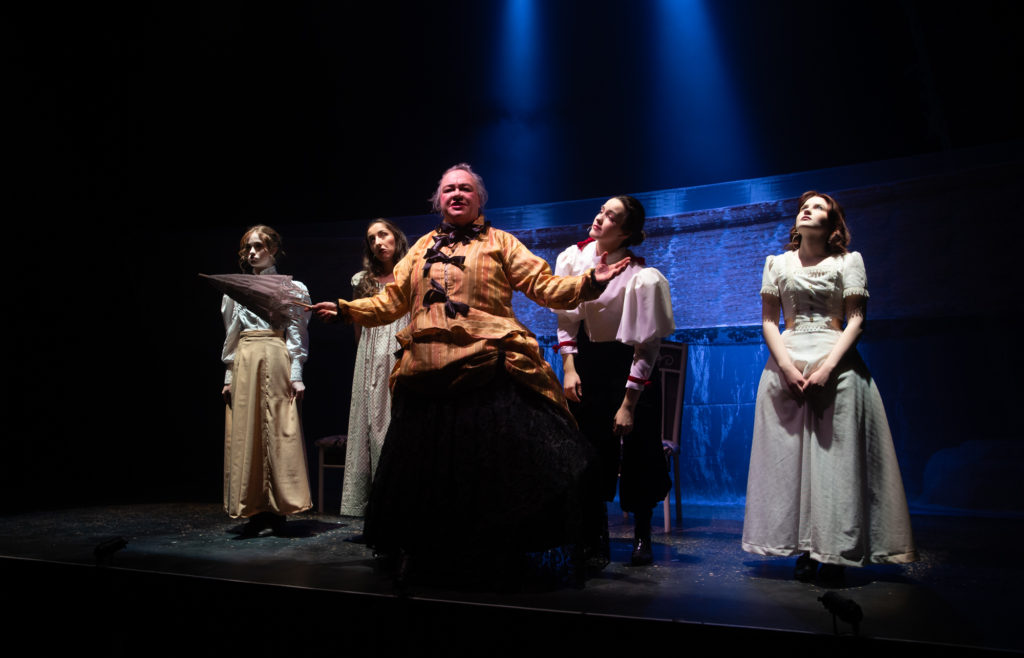
BY KEN CHISHOLM
Lindsay Thompson’s first musical staged at the Highland Arts Theatre was Herstory about a contemporary young woman seeking advice on her early life crisis from famous women from history. It was ardently feminist and seasoned with lashings of humour and some of the wittiest song lyrics yet presented on the HAT stage.
Her latest musical, See Jane Run, has all of the same qualities of Herstory but with a stronger story as well as some surprising twists on one of the most well-known popular culture “myths” of the last century. And it has a dancing dung beetle.
Jane Porter lives a pampered, suffocating life in late Edwardian England with her mother and three sisters (I’m guessing about the time period since it is never specified in the script, but the first Tarzan story appeared in 1912). Her mother’s (Carol Anne Gillis) one life mission—which she pursues with terrifying relentlessness—is to instill in her offspring the proper habits and behaviours of an upper-class lady until the time they can each be married off and become some man’s responsibility. Even in their fumbling attempts at rebellion, the four young women allow themselves to be slotted into prefabricated identities: Jane (Leslie MacLean) is the feisty bookish one; Nellie (MacKenzie Sechi) is the feisty feminist; Ada (Mea Tonet) is the feisty artistic one; and Olive (Rachel Murphy), being the youngest, is the non-feisty overlooked one.
Mother has arranged, on Jane’s behalf and to her horror, a marriage to William, a socially-awkward young entomologist. To Jane’s surprise, they share a passion for bugs and collaborate on a scholarly tome on the subject. While on a sea cruise to gather observations in the field, Jane discovers William has allowed her name to be dropped as co-author because the publisher argued, as a mere female, she lacked credibility as a proper scientist. They argue, Jane storms off, she’s washed overboard, and awakes to find herself marooned on a sandy beach at the edge of a great dark jungle, alone and free to do as she pleases for the first time in her life—but not for long…

From there, we get a mixture of the Tarzan story with some interesting emotional twists and none of which I will spoil if you have not seen the show.
There is an intelligence, spiced with a sharp wit and seasoned with an emotional sensitivity, that shines through every line of Thompson’s script. Even more than in Herstory, Thompson deploys a theatrical use of magic realism to carry the action along without it lapsing into whimsy. All of her characters are boldly-drawn and engaging. Her lyrics are insightful and very funny (especially those involving dung beetles) and, combined with Suzanne Doanne’s spritely musical settings, create several show-stopping moments (said dung beetle song “Overboard”, which is a tonic for the plethora of Disney “princess” empowerment songs, and a late in the show heartfelt ballad from an unexpected character).
I attended a reading at Doktor Luke’s coffee shop of an earlier version of the script in the fall sponsored by the Playwrights Atlantic Resource Centre and the 2018 HAT Playwrights Unit, and was impressed by what a stage-ready work Thompson had created. Since then, one or two songs have been moved that better suited the flow of the piece, and, I think, some judicious editing has added more snap to the narrative. Some may question Thompson’s deliberate use of contemporary speech idioms in a period piece, but I think her decision allowed a present day audience to engage with her play without it feeling like a school trip to a dusty museum.
And as accomplished as Thompson’s script is in the version onstage, her efforts are matched by every level of the production team and onstage cast.
Alison Crosby will be familiar as an onstage performer (most recently at the HAT in Next to Normal) but as director of See Jane Run she makes a technically difficult piece seem effortless and highly entertaining. The play is in constant motion without seeming stagy (even in the confined opening scenes played mostly downstage). Every performance is emotionally on target with each line delivered for maximum effect, a sign the director is paying attention to both the script and their performers. I look forward to Crosby’s next big show at the HAT or elsewhere.
Along with composing the songs with Thompson, Suzanne Doanne, as musical director, did an intelligent and winning job of arranging her score. With a small pit orchestra of Peter MacDonald on piano, Barb Stetter on woodwinds, Geoffrey Lee-Dadswell on cello, and herself on violin, Doane created a lush musical landscape, from formidable feminist anthems to heartfelt love ballads to comedic novelty numbers. I particularly enjoyed her vocal arrangements: songs became four- and five-part harmony choral numbers, and occasionally soared into musical rounds, with all of the cast note-perfect on some intricate vocal parts.

Thomas L. Colford (who also performed as the Ape-Man) provided some charming choreography that showed his dancers to their best advantage: any kick line that includes Tarzan is a winner with me. Like Crosby’s direction, it moved the story along without any unnecessary flourishes.
Bradley Murphy’s set design went seamlessly from Edwardian dressing room (created with just four chairs and a curtain) to primal jungle aided by Ken Heaton’s evocative lighting design. Kayla Cormier, as for many HAT productions, contributed to the reality of this fantasy with her eye-pleasing costume design and props (and where in Cape Breton does one find a suitable loincloth?). And a special mention to sound technician, Ohan Vandermeer, who created a smooth mix of wireless mic vocals in the whirlwind of onstage monkey business.
Lesley MacLean gave an exuberant, high energy performance as Jane. As in her other HAT appearances, the audience takes to her the second the stage lights hit her. MacLean made something look easy that is actually very hard, that, with the mix of “real” and “imaginary” characters onstage, a lot of the play is happening in Jane’s head. MacLean is a trained dancer and choreographer and that shows in her grace and ability to take a pratfall. And, with musical director Doane’s guidance, this is the strongest singing performance I’ve seen her give in any of her HAT appearances.
Wesley Colford has cornered the Cape Breton market on loveable doofuses. After appearing in countless HAT productions together, he, as the hapless William, and MacLean have an effortless onstage chemistry together. He gives it his all which includes reaching his pinnacle of romantic leading man pretending to be a giant ball of dung rolling across the HAT stage.

MacKenzie Sechi, Mea Tonet, and Rachel Murphy made real characters of Jane’s three sisters that the audience could invest their emotions in even when for long stretches of the play they acted as a Greek chorus. Physically, they matched their characters: the statuesque Sechi as the militant women’s rights activist, Tonet with dark flowing locks as the poetic narcissist, and petite Murphy as the overlooked baby of the family (director Crosby used their height differnece to create some interesting visual tableaux). They were confident dancers and they easily navigated the intricate vocal arrangements.
Carol Ann Gillis’ Mother made Queen Victoria look like a liberal softie. Pursuing her errant daughters across the stage like an aggrieved dreadnought, Gillis yet seemed more than a cut-out villain. She made her concern real and one could believe her sternness was hammered on the forge of Victorian values. And when she sang, it was bliss to hear a confident, mature, capable vocal performance of such high caliber.
Thomas L. Colford, an accomplished professional dancer, brought a powerful physicality to his Tarzan. He scampered on all fours, leapt over rocks, and climbed vine-covered jungle vegetation with ease. He also had perfect comedic timing with his newly learned English vocabulary, and he exhibited an ability to take a rock to the head with grace and humour. His Tarzan was not just another shirtless Man-Ape with oiled pectorals gleaming in the jungle sun (and, no matter what other praise I heap upon this excellent production, I think with that last sentence I might have sold out the rest of the run of the show).
And one absolutely must mention Geoffrey Lee-Dadswell as the show stealing Dung Beetle. If anyone wonders what a six-foot tall dung beetle attired in black leotard would look like, it would have to be damn close to Lee-Dadswell’s interpretation: blank-faced, intent on his purpose as a dung beetle, not really sure of how it found itself onstage being led through some fanciful choreography by a pesky human. The two teenaged girls sitting next to me, like the entire audience around them, almost fell out their seats they were laughing that hard.
See Jane Run runs 8 pm nightly at the Highland Arts Theatre, 40 Bentinck Street, Sydney, until Sunday, March 17.

